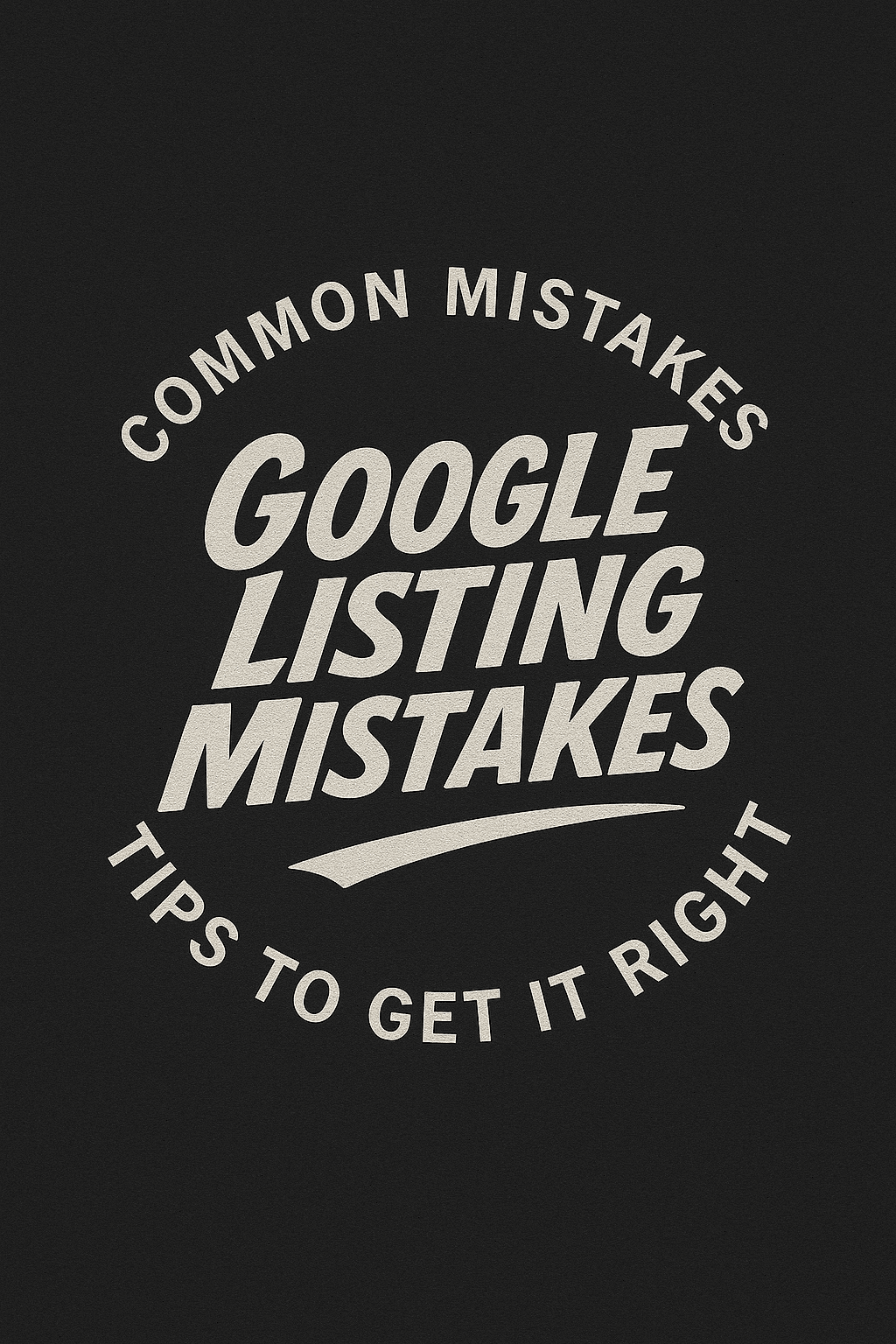
If you’re a small or local business trying to get found online, one of the most powerful tools you have is your Google Business Profile (formerly Google My Business). But just claiming your listing isn’t enough. There are a lot of ways to get it wrong—and those mistakes can cost you traffic, customers, and credibility.
In this post, we’ll go deep into the most common Google Business Profile mistakes businesses make, why they matter, and how to fix them. If you’re trying to improve your local SEO and get more eyes on your business, this guide is for you.
1) Not Claiming or Verifying Your Listing
It seems obvious, but you’d be surprised how many businesses still haven’t claimed or verified their Google Business Profile. If you don’t verify your listing, you don’t control it. That means someone else could suggest changes or even hijack it.
Why it’s a problem:
- You can’t respond to reviews
- You can’t update your hours, photos, or services
- Google might show outdated or wrong information
Fix it:
Head to Google Business Profile and go through the steps to claim and verify your business. Google will usually send a postcard with a verification code, but there are other options depending on your industry and setup.
2) Using the Wrong Business Name
Your business name should be exactly what’s on your storefront, signage, or legal documents. Don’t try to keyword stuff your business name like:
“Joe’s Plumbing – Affordable 24/7 Emergency Services Longview WA”
Why it’s a problem:
- It violates Google’s guidelines
- It can get your listing suspended
- It makes your business look unprofessional
Fix it:
Use your real-world business name. If you want to target keywords, use them in your description, services, and posts instead.
3) Listing the Wrong Category
Categories help Google understand what your business does. If you pick the wrong one—or skip this entirely—Google won’t show your listing to the right people.
Why it’s a problem:
- You’ll appear in irrelevant searches
- You’ll miss out on customers actually looking for your services
Fix it:
Choose a primary category that most accurately describes your core service. Then add a few additional categories if needed. Don’t overdo it though—only pick ones that truly apply.
4) Not Adding Business Hours or Keeping Them Updated
People need to know when you’re open. If your hours are missing, wrong, or inconsistent with your website or social media, it creates confusion.
Why it’s a problem:
- Customers may show up when you’re closed
- Google may lower your ranking due to inconsistency
Fix it:
Log into your profile and keep your hours current. Don’t forget to update them for holidays and special occasions—Google even has features that let you do this easily.
5) Ignoring Reviews (Especially the Bad Ones)
Reviews are one of the first things people see when they find your business on Google. Not responding to them—or only replying to positive ones—sends the wrong message.
Why it’s a problem:
- Looks like you don’t care about customer feedback
- Can hurt your local ranking
- Missed opportunity to turn a bad review into a win
Fix it:
Respond to every review—good, bad, or neutral. Thank people for good ones. For bad ones, stay calm, professional, and offer to make things right.
6) Inconsistent NAP (Name, Address, Phone Number)
Google relies on consistency across the web to verify that your business is legit. If your info isn’t the same everywhere, it can hurt your credibility.
Why it’s a problem:
- Confuses customers
- Damages your local SEO
- Can cause duplicate listings
Fix it:
Make sure your NAP is exactly the same on your Google listing, website, social media, and online directories. No variations, no missing suite numbers, no typos.
7) Poor Quality or Missing Photos
Photos give people a sense of who you are. A profile without pictures—or with blurry, outdated ones—can turn people away.
Why it’s a problem:
- Reduces trust and interest
- Less likely to get clicks or visits
Fix it:
Add high-quality images of your business, products, team, and location. Keep them updated. Include both interior and exterior shots, and tag them properly.
8) Not Using the Business Description Effectively
Your business description is prime real estate. Too many businesses either leave it blank or write a generic sentence or two.
Why it’s a problem:
- Wasted opportunity to stand out
- Doesn’t help Google understand what you do
Fix it:
Write a compelling, keyword-rich description that speaks to your ideal customer. Avoid hype. Focus on what you offer, who you help, and what makes you different.
9) Forgetting to Add Services and Products
Google gives you a chance to list out your services and products. Not using this section is like having an empty menu at a restaurant.
Why it’s a problem:
- Limits your visibility for service-specific searches
- Doesn’t help people understand what you offer
Fix it:
Add every core service or product you offer. Include descriptions and prices where applicable. This helps with both SEO and conversions.
10) Not Using Google Posts
Google Posts are a way to share updates, offers, events, and news directly on your listing. But many businesses ignore this feature entirely.
Why it’s a problem:
- Missed chance to engage with customers
- Google gives preference to active profiles
Fix it:
Use Google Posts regularly. Even just one per week helps. Keep them short, visual, and actionable. Think: specials, announcements, or tips.
11) Having Multiple Listings for the Same Location
Sometimes, businesses end up with duplicate listings—either because they moved locations, changed names, or someone else created a second listing.
Why it’s a problem:
- Confuses searchers
- Dilutes your reviews
- Can hurt rankings
Fix it:
Use Google’s “Suggest an Edit” or “Report a Problem” to merge or remove duplicates. If you’re unsure, reach out to Google Support.
12) Choosing a Service Area That’s Too Broad
Service-area businesses (like plumbers or delivery services) can define where they operate. But trying to cover a massive area isn’t always smart.
Why it’s a problem:
- Google may see it as spammy
- Can lower your visibility in your actual core service area
Fix it:
Choose a realistic, local service area. Focus on your most profitable cities and zip codes.
13) Neglecting Attributes and Highlights
You can add specific attributes like “Wheelchair Accessible,” “Women-Owned,” or “Veteran-Owned”—and they matter to searchers.
Why it’s a problem:
- You miss out on people filtering listings based on attributes
- Doesn’t showcase what sets you apart
Fix it:
Go to your profile and add every attribute that applies to your business.
14) Not Linking to the Right Website
You’d be shocked how many listings point to outdated, broken, or incorrect websites—or no website at all.
Why it’s a problem:
- Users bounce
- Damages credibility and SEO
Fix it:
Double-check that your listing links to your current, secure (https) website. If you change your domain, don’t forget to update your Google listing.
15) Not Using UTM Tags for Tracking
If you’re running Google Ads or tracking website traffic, not using UTM tags is a lost opportunity.
Why it’s a problem:
- Can’t accurately measure how many leads come from your listing
Fix it:
Use UTM parameters on the website link in your profile to track clicks in Google Analytics. Example: ?utm_source=google&utm_medium=organic&utm_campaign=gbp
16) Leaving Q&A Unmonitored
Google listings allow people to ask questions publicly—and anyone can answer. If you’re not watching this section, wrong info can slip in fast.
Why it’s a problem:
- Misinformation spreads
- Looks like you’re not involved in your business
Fix it:
Regularly check the Q&A section and provide accurate answers. You can even seed common questions yourself with answers.
17) Failing to Monitor Insights
Google provides analytics (called Insights) to help you understand how people find and interact with your listing. Most businesses don’t check this.
Why it’s a problem:
- You miss out on data to guide decisions
Fix it:
Review your Insights regularly. Look at how people find you (search vs. maps), what actions they take (calls, website visits), and optimize accordingly.
Final Thoughts
Your Google Business Profile is often your first impression online. It can help you rank better, attract more local customers, and build trust with your audience—but only if you set it up and manage it the right way.
If you’re making any of the mistakes above, don’t worry. Most of them are easy to fix, and the payoff is well worth it.
Need help with your Google Listing? Contact us and let’s make sure your business shows up where it counts.





